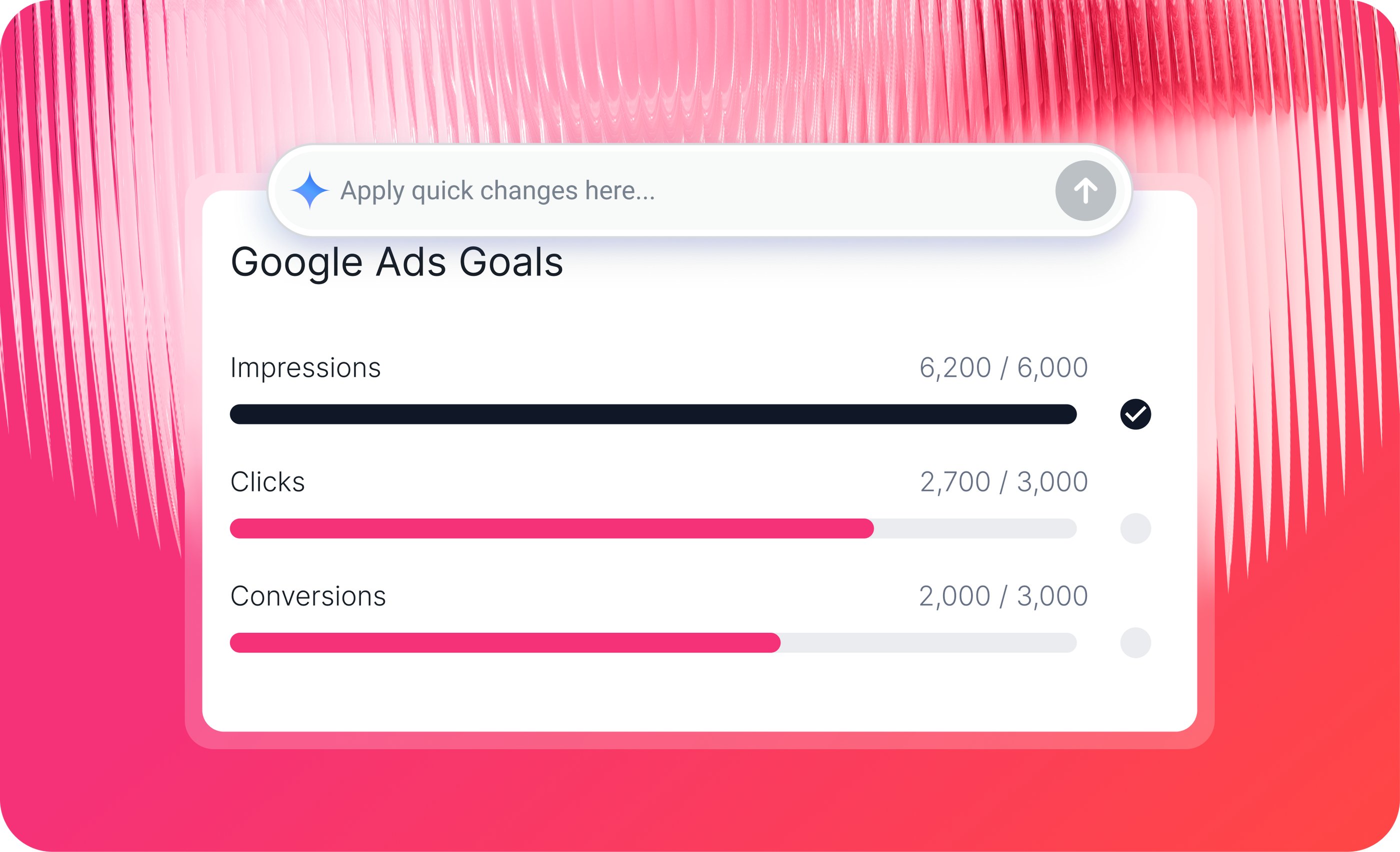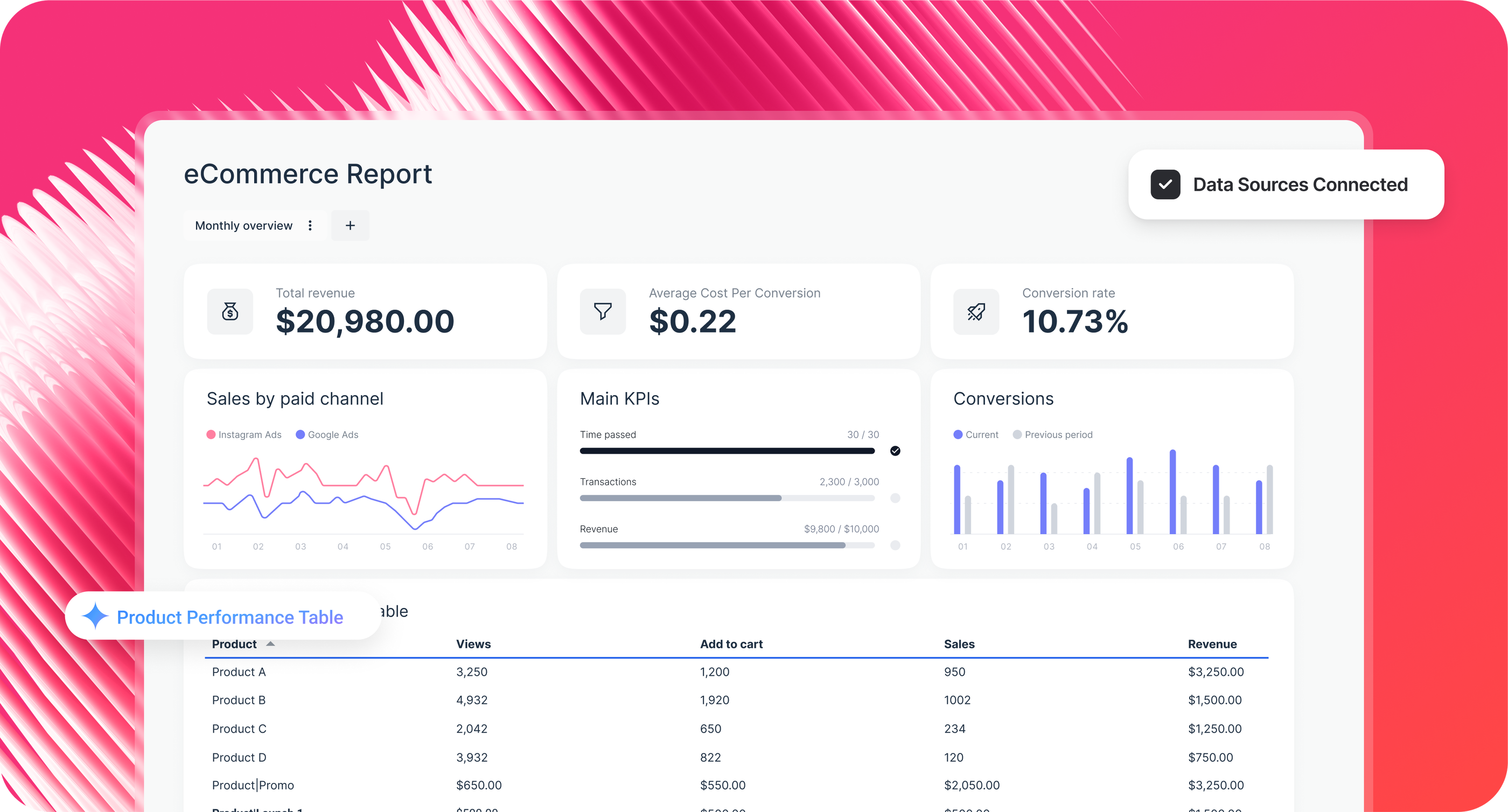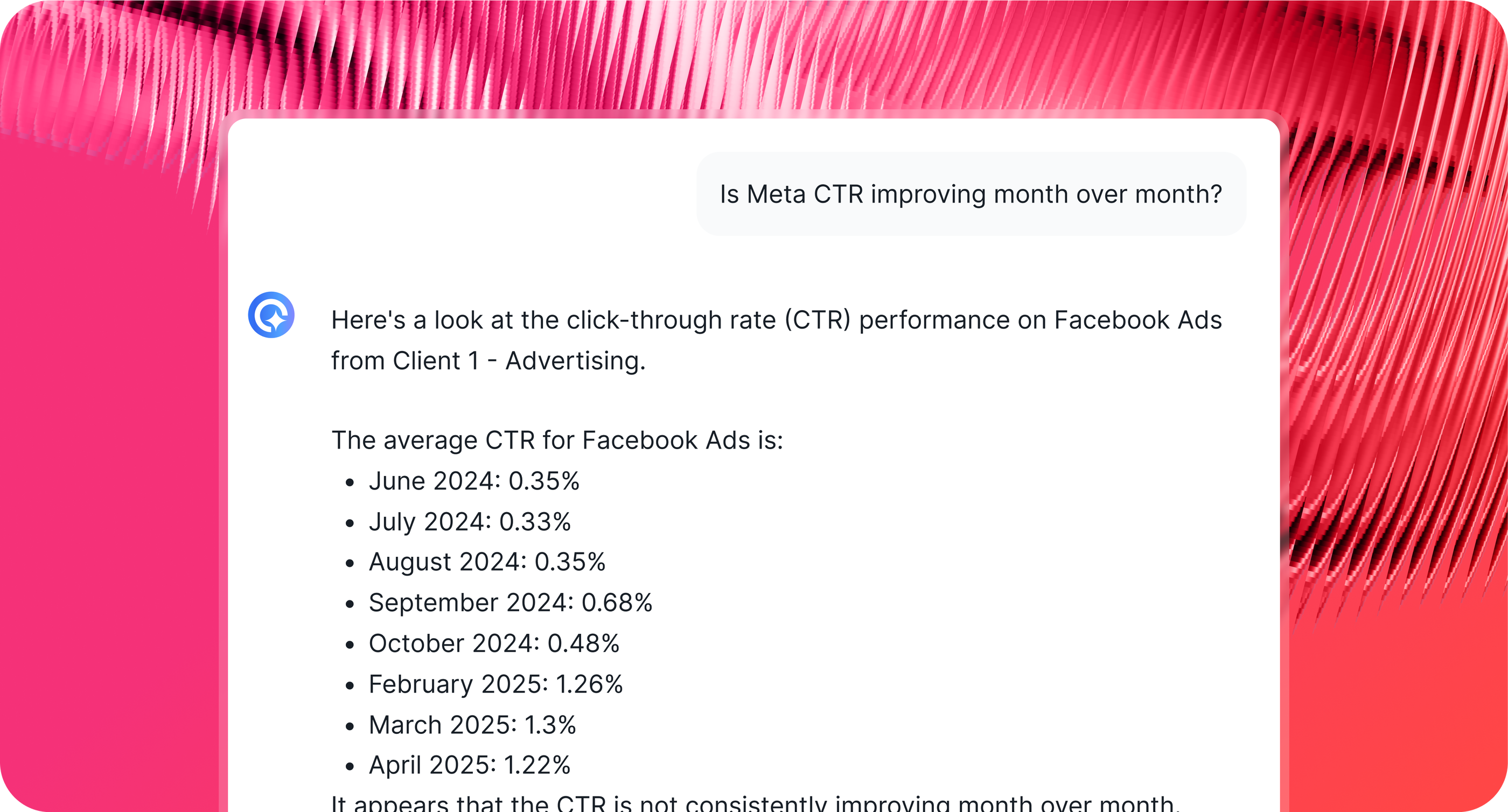Challenges
Slow dashboards. Broken connections. Data overload.
Led by the visionary Lars Maat, Maatwerk Online is one of the Netherlands’ most prestigious agencies, serving over 100 clients nationwide.
But when it comes to client reporting, something was (literally) slowing the team down.
The team was using a “Frankenstack” of Supermetrics and Looker Studio which proved to be more of a burden than a solution.
“Looker Studio was really slow,” Lars explained. “We used Supermetrics to connect our channels, but sometimes they would just break. Tables didn’t load when you tried to refresh the dashboard. It was really annoying.”
It wasn’t just technical issues either. Looker Studio reports were bloated with dozens of metrics, most of which clients never looked at.
“I got the feeling we were actually rebuilding Google Analytics,” Lars said. “There were so many metrics and so many tables that no one was using. That’s not how reporting should be.”
For Lars, a report should only focus on what matters: top-level KPIs, clear targets, and profitability.
“Your reporting dashboard should always be about the main KPIs. Are we hitting targets? What are we spending? How much profit is that gaining?” Lars said. “And if clients want to go deeper, they can go to Google Analytics or Google Ads Manager.”
Instead, Looker Studio reports were a data dump—slow, bloated, and increasingly unstable as the client list grew.
“The bigger the dashboard was, the bigger the chances were that not everything would load properly,” complained Lars. “At one point, it just became worse and worse.”
That’s when the team started looking for a better way to do reporting—something faster, easier, and built for actionable insights.
Looker Studio was really slow. We used Supermetrics to connect our channels, but sometimes they would just break. It was really annoying.
Solution and Implementation
Phase 1: Choosing Whatagraph
When Lars set out to replace the current stack, he tested multiple platforms and collected feedback from internal teams.
Lars initially shortlisted a tool he liked, but it wasn’t “good enough” for the team because it didn’t have all the integrations they needed—which were available on Whatagraph.
“Some of the tools we use internally weren’t compatible with that reporting tool. But they were compatible with Whatagraph,” he said. “That gave us the initial confidence to move forward.”
Whatagraph didn’t just tick the boxes on integrations. Lars loved that they were able to customize reports fully on Whatagraph, set clear targets, and start every dashboard with what really matters: performance goals and progress.
“On Whatagraph we could build a dashboard for each client that includes a goal bar—these are the targets, and this is where we are today,” said Lars. “That was pretty nice. I hadn’t seen that before.”

This, combined with the green light from internal teams, Maatwerk Online switched to Whatagraph.
Here's what Lars himself has to say about why they chose Whatagraph:
Phase 2: Getting clients onboard
As an agency owner, it was incredibly important for Lars that clients were onboard with the new way of reporting on Whatagraph—that they would see it as a value-add, rather than something disruptive.
So, he did something incredibly smart that we recommend every agency do.
He ran a live webinar to introduce Whatagraph to all their clients, walking them through the upgraded reports—what’s included, what changed, and how to read them.
“We used the point of working together with Whatagraph as a unique selling point to our clients,” Lars explained. “We branded it as something unique and special, so clients were impressed and onboard right away.”
Phase 3: Building out templates
Once the clients were onboard, the next step was to build reports for them in Whatagraph.
To speed up this process, Maatwerk Online created 4 “pillar” reporting templates that can be reused across clients:
- eCommerce
- Leadgen
- Branding
- B2B

For 90% of clients, these templates work out of the box with minimal tweaks. For the rest, the team starts with a template and layer in custom widgets or data sources.
“Templates save so much headspace—you don’t have that negative energy of thinking, ‘Ugh, I have to build a report again.’,” Lars said.
Each client also gets a live link to their Whatagraph dashboard that they could use to look at performance and goals any time they wanted. This is critical to building trust and keeping clients within the agency.
Beyond the data, Lars sees Whatagraph’s reports as a reflection of the agency’s brand identity.
“When we share a report and it’s fully branded—our colors, fonts, logo, and the client’s logo—it looks professional,” he said. “And for clients, this gives them the feeling of ‘These guys know what they’re doing.’ That really matters.”
With our newly released Whatagraph IQ Themes, the team can now just upload a screenshot of their brandbook (or type a prompt) and Whatagraph will automatically apply the font and colors to the entire report—saving them even more time and energy.
Phase 4: Testing and implementing AI
Since they first onboarded Whatagraph two years ago, Maatwerk Online has been one of our most treasured customers.
So, naturally, when we launched Whatagraph IQ—a suite of AI features to create, style, and understand reports in seconds—Lars was among the first to test them.
He was impressed by these two key features:
1. AI Widget Creator
“Most of the time, the specialists aren’t keen on building reports,” Lars said. “They’re geeks. They want to work in the ad accounts. Reporting is just something that comes along.”
But with Whatagraph’s AI Widget Creator, his team can now just draw a space in the report grid, describe the widget they want in plain language—type, metrics, time range, filters—and Whatagraph builds it automatically.
“The AI widget creator saves time and energy for our marketing specialists,” Lars raved. “If they need to build reports themselves, it costs them negative energy. But if they can automate or speed it up with AI, it really gives them an energy boost—like ‘Hey this is working really nice. This is easy. This is going fast.’”
As a true Whatagraph champion, Lars rolled out this new feature to his team with a quick post in their internal Teams channel.
“I just said, ‘Hey guys, Whatagraph has an update. This is how it works. This is how you can use it.’ And I got all kinds of thumbs up and heart emojis—so I think they’re really keen on it.”
Watch what Lars said about the AI Widget Creator:
2. AI Chat
Lars himself is a big fan of the Whatagraph IQ chat—an AI assistant built into reports that lets you ask questions about your data and get accurate answers in seconds.
“Let’s say you’re in a client meeting and they ask a bunch of questions,” he said. “Instead of saying, ‘Let me get back to you,’ you can just ask the AI chatbot and get the numbers right away. That’s really amazing.”

Here's what Lars said about the AI Chat:
With both AI features, the team works faster, clients get answers sooner, and the agency strengthens its reputation as a trusted, proactive digital partner.
Phase 5: Building an internal feedback loop
Apart from the hard features, Lars appreciates that the Whatagraph team always listens to feedback and continuously improves our platform based on it.
In fact, Lars even built an internal feedback loop: a “Whatagraph playbook” with a request form where team members can submit anything—from new widget ideas to integration requests to tweaks for existing templates.
“Whenever there’s feedback, it’s not just like ‘hey, we hate this,’” Lars explained. “It’s more like, ‘we love Whatagraph, and here’s something that would make it even better.’ That mindset has really helped us evolve how we use the platform.”
Once feedback is logged, Lars either builds the solution internally or passes it to Whatagraph.
For instance, when the SEO team needed a special integration, they requested it and Whatagraph delivered—proving the value of a partner who’s invested in their success.
Whatagraph’s AI saves time and energy for marketing specialists. If they need to build reports themselves, it costs them negative energy. But if they can automate or speed it up with AI, it really gives them an energy boost—like ‘Hey this is working really nice. This is easy. This is going fast.’
Results
100+ hours saved on reporting per month
Before Whatagraph, reporting was slow, clunky, and riddled with connection issues.
After switching to Whatagraph, Maatwerk Online now saves at least one hour per client, per month on creating reports.
With over 100 clients, that adds up to more than 100 hours every single month—a massive chunk of time freed up across the agency.
“The hours that we’re saving with Whatagraph is just pure profit,” Lars raved. “We now have time to focus on more strategic things that actually help both our agency and our clients grow.”
Lars talked more about these benefits in this video:
Up to €4,000 saved per year, broken-even on Whatagraph cost
Switching to Whatagraph also eliminated the €3,000–€4,000 per year the team used to spend on Supermetrics.
“Supermetrics is really expensive, and we don’t need to pay for it anymore now,” Lars said. “That is really, really cost saving.”
Maatwerk Online has also broken-even on the cost of Whatagraph by introducing report licensing fees for clients—covering 100% of reporting costs.
Raving internal feedback and supportive Support
Apart from the hard numbers, Whatagraph is also improving the day-to-day workflow for specialists across the agency.
“The feedback I hear from our team is, ‘Oh my God, building reports is so much easier nowadays’,” Lars said. “It’s still not the favorite thing to do as a specialist, but with Whatagraph, it’s really easy and fast to build a report for your client.”
Whatagraph’s user-friendly interface and customizable templates mean specialists can create client reports quickly, without having to wrestle with complicated setups or broken data.
Behind the scenes, Lars and his team had direct access to their dedicated Customer Success Manager, our lovely Misha, who helped guide them through onboarding, feature rollouts, and new use cases.
“Having your own account manager who gives you updates, shows you how to use new features, and checks in regularly is really helpful,” Lars said. “As a busy agency, having someone proactively show you what’s possible makes a huge difference.”
Not a software vendor, but a strategic business partner
As someone who’s passionate about AI, Lars views Whatagraph’s AI features not just as automation or cost-saver—but as a sign that Whatagraph is genuinely invested in helping agencies succeed.
“The fact that you’re developing these AI features gives me the feeling that you’re really on top of it,” he said.
“That you’re worth the money we’re paying because you keep improving the platform and making suggestions we’ll like. That gives me the feeling like—‘they got this.’ We just follow along. And that's really a nice feeling to have.”
In his words, it’s a relief not to have to think about where the industry is going or what tools to add—because Whatagraph is already ahead of it.
Lars’ recommendation
When asked if Lars would recommend Whatagraph to other agencies, he laughed and said:
“You should ask Justas (Whatagraph’s CEO) that question. But truly though, I can name four or five agencies in the Netherlands who started using Whatagraph because of all the good things we were saying about it.”
And when asked what these “good things” were, he listed them out:
✅ Meeting all reporting needs from day one – Whatagraph ticked all the boxes for integrations and report customization.
✅ Hands-on onboarding and template building – With the help of their dedicated Customer Success Manager, they set up custom templates that made reporting faster and more consistent.
✅ Ongoing improvements – Regular updates and new features continued to make Whatagraph better over time.
✅ Exclusive beta testing – Lars gets early access to upcoming features, with the chance to provide feedback before they go live.
✅ Feedback that’s actually used – Suggestions don’t disappear into a void; they’re reviewed, implemented, and followed up on.
For Lars, these aren’t just nice-to-have perks—they’re proof of a real strategic partnership built on responsiveness and trust.
“The relationship between us as an agency and you as a vendor is healthy and based on mutual respect. That gives me a really good feeling—and that’s why I’m happy to refer you to others,” Lars concluded.
The hours that we’re saving with Whatagraph is just pure profit. We now have time to focus on more strategic things that actually help both our agency and our clients grow.

